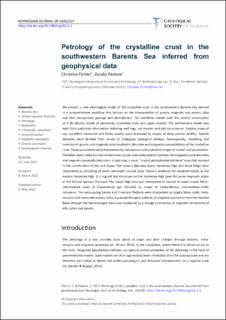| dc.contributor.author | Fichler, Christine | |
| dc.contributor.author | Pastore, Zeudia | |
| dc.date.accessioned | 2023-01-20T08:57:48Z | |
| dc.date.available | 2023-01-20T08:57:48Z | |
| dc.date.created | 2022-06-13T13:35:12Z | |
| dc.date.issued | 2022 | |
| dc.identifier.citation | Norwegian Journal of Geology. 2022, 102 . | en_US |
| dc.identifier.issn | 2387-5844 | |
| dc.identifier.uri | https://hdl.handle.net/11250/3044836 | |
| dc.description.abstract | We present a new petrological model of the crystalline crust in the southwestern Barents Sea derived in a comprehensive workflow that focuses on the interpretation of gravity, magnetic and seismic data and that incorporates geology and petrophysics. The workflow started with the careful construction of a 3D density model of sediments, crystalline crust and upper mantle. The sedimentary model was built from published information including well logs, net erosion and salt occurrences. Existing maps of top crystalline basement and Moho depths were improved by means of deep seismic profiles. Mantle densities were derived from values of analogous geological settings. Subsequently, modelling and inversion of gravity and magnetic data resulted in densities and magnetic susceptibilities of the crystalline crust. These parameters were interpreted by comparison with published ranges of crustal rock parameters. The latter were linked to a two-dimensional colour scale dedicated to combine the mapped crustal densities and magnetic susceptibilities into a single map, a novel "crustal petrophysical attribute" map that assisted in the classification of the rock types. The eastern Bjørnøya Basin, Veslemøy High and Senja Ridge were interpreted as consisting of mafic–ultramafic crustal rocks. There is evidence for serpentinisation at the eastern Veslemøy High. It is argued that intrusions on the Veslemøy High have the same magmatic origin as the Seiland Igneous Province. The Loppa High area was interpreted to consist of upper crustal felsic–intermediate rocks of Precambrian age intruded by chains of Carboniferous intermediate–mafic intrusions. The surrounding basins and Finnmark Platform were interpreted as largely felsic–mafic metamorphic and metasedimentary rocks. A gradual change in polarity of magnetic anomalies from the Harstad Basin through the Sørvestsnaget Basin was explained by a change in direction of magnetic remanence of sills, dykes and basalts. | en_US |
| dc.language.iso | eng | en_US |
| dc.publisher | Geological Society of Norway | en_US |
| dc.rights | Navngivelse 4.0 Internasjonal | * |
| dc.rights.uri | http://creativecommons.org/licenses/by/4.0/deed.no | * |
| dc.title | Petrology of the crystalline crust in the southwestern Barents Sea inferred from geophysical data | en_US |
| dc.title.alternative | Petrology of the crystalline crust in the southwestern Barents Sea inferred from geophysical data | en_US |
| dc.type | Peer reviewed | en_US |
| dc.type | Journal article | en_US |
| dc.description.version | publishedVersion | en_US |
| dc.source.pagenumber | 43 | en_US |
| dc.source.volume | 102 | en_US |
| dc.source.journal | Norwegian Journal of Geology | en_US |
| dc.identifier.doi | 10.17850/njg102-2-2 | |
| dc.identifier.cristin | 2031434 | |
| cristin.ispublished | true | |
| cristin.fulltext | original | |
| cristin.qualitycode | 1 | |

